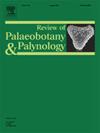There and back again; on dinoflagellate cyst index events of the Eocene - Oligocene Transition in the (Para)Tethyan Realm
IF 1.7
3区 地球科学
Q2 PALEONTOLOGY
引用次数: 0
Abstract
A recent biochronostratigraphic (coccolithophorids, dinoflagellate cysts) and paleoenvironmental analysis of the hemipelagic deposits of the İhsaniye Formation, exposed along the cliffs in the Karaburun area (Black Sea coast, NW Turkey) provided new insights into the paleoceanographic and paleoclimatic evolution of the central (Para-)Tethyan region across the Eocene–Oligocene Transition (EOT). Among others, the study identified the Earliest Oligocene Stable Isotope Step (EOIS) marking the inception of Antarctica's first continental-scale ice sheets since the mid-Permian and coinciding with a major eustatic lowering, followed by the Early Oligocene Glacial Maximum (EOGM) period with its peak δ18O values. The study showed apparent (quasi) continuity of the EOT succession at Karaburun, a notion that is not a 100% obvious from the organic walled dinoflagellate cyst (or dinocyst) record. This is mainly because the iconic Eocene – earliest Oligocene taxon Areosphaeridium diktyoplokum, in coeval sections in the region quite abundant near the end of the Eocene, is virtually absent. Here, we focus on obtaining a more detailed picture of correlative secondary dinocyst and other EOT bioevents allowing an even more robust chronostratigraphic assessment of the succession, including correlation to the Italian type sections. Particularly the ranges of the (herein taxonomically revised) species Explodinium priabonensis gen. and comb. nov. and the new species Glaphyrocysta peterbijlii sp. nov. may be regarded as additional criteria to correlate EOT strata within the (Para)Tethyan realm. Combined evidence now suggests that the Karaburun section may not be as complete as previously assumed and that a small part of the succession correlative to the base of the EOGM, representing a portion of the Adi dinocyst Zone may be missing. This aspect does not affect the overall outcome and significance of the studies at Karaburun. In fact, a brief hiatus may well be driven by the major EOT sea level lowering.
来去匆匆;特提斯地区始新世-渐新世过渡时期鞭毛藻囊指数事件的研究
最近对土耳其西北部黑海沿岸卡拉布伦地区(Karaburun)悬崖上暴露的İhsaniye组半深海沉积物的生物年代地层(球石藻、鞭毛藻囊)和古环境分析,为特提斯中部(Para-)地区在始新世-渐新世过渡时期(EOT)的古海洋学和古气候演化提供了新的认识。其中,研究确定了早渐新世稳定同位素台阶(EOIS),标志着自中二叠纪以来南极洲第一个大陆尺度冰盖的开始,与一次主要的海平面上升下降相吻合,随后是早渐新世冰川极大期(EOGM),其δ18O值达到峰值。该研究显示Karaburun的EOT演替具有明显的(准)连续性,但从有机壁鞭毛藻囊肿(或dinocyst)记录来看,这一概念并非100%明显。这主要是因为始新世至最早渐新世的标志性分类群Areosphaeridium diktyoplokum在该地区近始新世末期相当丰富的同期剖面中几乎没有。在这里,我们的重点是获得相关的次生恐龙囊和其他EOT生物事件的更详细的图片,从而对演替进行更可靠的年代地层评估,包括与意大利类型剖面的相关性。特别讨论了(在此进行了分类学修订的)种priabonensis generia和comb的分布范围。11 .和新种Glaphyrocysta peterbijlii sp. 11 .可被视为特提斯(Para)领域EOT地层的附加标准。综合证据表明,卡拉布伦剖面可能不像以前假设的那样完整,与EOGM基底相关的一小部分演替可能缺失,代表阿迪囊泡带的一部分。这方面并不影响Karaburun研究的总体结果和意义。事实上,一个短暂的间歇很可能是由主要的EOT海平面下降所驱动的。
本文章由计算机程序翻译,如有差异,请以英文原文为准。
求助全文
约1分钟内获得全文
求助全文
来源期刊
CiteScore
3.50
自引率
21.10%
发文量
149
审稿时长
6 months
期刊介绍:
The Review of Palaeobotany and Palynology is an international journal for articles in all fields of palaeobotany and palynology dealing with all groups, ranging from marine palynomorphs to higher land plants. Original contributions and comprehensive review papers should appeal to an international audience. Typical topics include but are not restricted to systematics, evolution, palaeobiology, palaeoecology, biostratigraphy, biochronology, palaeoclimatology, paleogeography, taphonomy, palaeoenvironmental reconstructions, vegetation history, and practical applications of palaeobotany and palynology, e.g. in coal and petroleum geology and archaeology. The journal especially encourages the publication of articles in which palaeobotany and palynology are applied for solving fundamental geological and biological problems as well as innovative and interdisciplinary approaches.

 求助内容:
求助内容: 应助结果提醒方式:
应助结果提醒方式:


